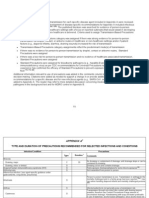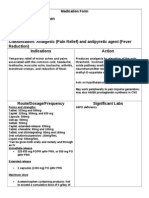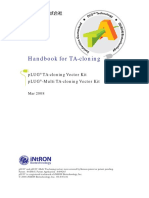Medical Surgical Nursing - Diabetes
Medical Surgical Nursing - Diabetes
Uploaded by
tripj33Copyright:
Available Formats
Medical Surgical Nursing - Diabetes
Medical Surgical Nursing - Diabetes
Uploaded by
tripj33Original Description:
Copyright
Available Formats
Share this document
Did you find this document useful?
Is this content inappropriate?
Copyright:
Available Formats
Medical Surgical Nursing - Diabetes
Medical Surgical Nursing - Diabetes
Uploaded by
tripj33Copyright:
Available Formats
Clinical Topic #7 Diabetes Management Student Guide
Objectives: Student will: Discuss pathophysiology, assessments, and nursing interventions or the prevention and treatment o diabetic ulcers! Describe the purpose and process o blood glucose and urine "etones monitoring! Di erentiate between various insulin preparations! #$plain how to mi$ insulins accurately! Describe administration o insulin with various devices! Discuss pathophysiology, symptoms and interventions or hypoglycemia! FYI Normal Blood Glucose Levels: Kee states 60-110 mg/dL, Fundamentals 70-105 mg/dL, and Lewis 70-120 mg/dL. Students will only be tested on values wit in no!mal o! abno!mal limits "o! all o" t ese !anges. #oweve! students may want to lea!n t e Lewis level "o! ease in t!ansition to subse$uent semeste!s. Nursing Diagnosis: %mpaired Tissue %ntegrity &lood 'lucose, (is" or )nstable %n ection, (is" or *C: +ypoglycemia,+yperglycemia Discussion Questions: -! .hat puts the diabetic patient at ris" or oot ulcers/ Diabetic patients are at ris" o developing diabetic neuropathy, more speci ically, sensory neuropathy! Sensory neuropathy can cause loss o sensations li"e numbness o hands and eet and the sensations o temperature! .hen loss o sensations occur, it ma"es it harder or the patient to identi y when in0ury or in ection occurs, ma"ing it more di icult or the patient to identi y when s"in brea"down is occurring!
1! +ow would you assess the eet o a patient with diabetes/ %n a hospital setting % would chec" capillary re ill o the toes! % would loo" or any redness, swelling, blisters, or cuts on the oot! % would recommend they receive a screening using a mono ilament to asses 23*S! 4! .hat might you teach a patient to prevent diabetic oot ulcer development/ .ash 5eet daily with mild soap and warm water
*at dry gently, especially between toes #$amine eet daily or cuts, blisters, swelling, and tender areas )se mild oot powder or sweaty eet (epeat s"in in ections and non6healing sores .ear clean, absorbent soc"s or stoc"ings that have not been mended 7! Describe appropriate interventions to promote healing o oot ulcers! Casting may be appropriate in order to redistribute weight on the plantar sur ace o the oot! 3ther orms o wound control or oot ulcers would include: debridgement, dressings, advanced wound healing products such as (egrane$, vacuum6assisted closure, ultrasound, hyperbaric o$ygen, and s"in gra ting! 8! Describe purpose and procedure or blood glucose monitoring! The monitoring o a person9s blood glucose level allows them to ma"e sel 6management decisions regarding diet, e$ercise, and medication! 3ne method o monitoring a persons blood glucose level is by the use o portable blood glucose meter, which ta"es a small drop o capillary blood and assesses the amount o glucose within it! :nother way o measuring a person9s blood glucose is by the use o a Continuous 'lucose Monitoring system! This system uses needles inserted subcutaneously that assess the blood glucose level every -68 minutes! ;! Describe the purpose and procedure or urine "etones monitoring! Monitoring urine "etones helps to prevent the development o conditions such as "etonuria or even worse, diabetic "etoacidosis! To monitor urine "etones, you will need testing dipstic", and a sterile urine cup! Collect the urine in the sterile cup, and using the testing dipstic", dip it into the urine! : positive result can indicate lac" o insulin and diabetic acidosis! 7! #$plain how insulin preparations are di erent/ %denti y onset, pea" and duration or each! %nsulin is prepared base on the patients speci ic pattern o blood glucose levels, li estyle, eating, and activity patterns! The patient may receive mi$ed insulin, or they may receive multiple di erent doses! (apid :cting o 3nset: -8mins o *ea": ;<6=<min o Duration: 467hrs Short :cting
o 3nset: 4<6;<mins o *ea": 164 +ours o Duration: 46; +ours %ntermediate :cting o 3nset:167hr o *ea": 76-< hr o Duration: -<6-; hr
2ong :cting o 3nset: -61 hr o *ea": no *ronounced *ea" o Duration: 17>hr
?! .hat are the devices currently used to administer insulin/ %nsulin can currently be administered with an insulin pen, insulin syringes, an insulin pump, as well as through an %@!
=! .hat is the appropriate method or mi$ing two di erent insulin preparations/ .ash +ands 'ently rotate insulin bottle i cloudy .ipe o tops o vials with alcohol sponge %n0ect the appropriate amount o air into both vials %nvert vial & and draw bac" the medication (emove the needle, insert it in vial : and withdraw the medication
-<! #$plain the medical order or Acorrection doseB or Asliding scale!B
The term Asliding scaleB or Acorrection doseB re ers to the progressive increase in the pre6 meal or nighttime insulin dose, based on pre6de ined blood glucose ranges! Sliding scale insulin regimens appro$imate daily insulin reCuirements! --! .hat is hypoglycemia/ .hat are the causes and symptoms/ +ypoglycemia is having a low level o glucose within the blood! This can occur when the glucose within the blood is used too Cuic"ly, not enough glucose is being produced or absorbed, or the amount o insulin in the blood is too high! Symptoms include, con usion, sweating, diDDiness, nausea, and sleepiness! -1! +ow is hypoglycemia treated/ %ngesting sugars into the body helps to treat hypoglycemia! :lso ta"ing Meglitinides daily help to lower the chance o hypoglycemia rom happening in the irst place!
You might also like
- Clinical Log Term II PDFDocument9 pagesClinical Log Term II PDFPriscilla S100% (1)
- NGN 2023 Ati PN Comprehensive Exit Exam 2023 With NGN Actual Exam 100 CorrectDocument142 pagesNGN 2023 Ati PN Comprehensive Exit Exam 2023 With NGN Actual Exam 100 Correctgithijidennis99100% (1)
- VATI Med Surg RemediationDocument2 pagesVATI Med Surg RemediationestberryNo ratings yet
- ATI CompDocument9 pagesATI CompTee Wood100% (1)
- Peds HESI Study GuideDocument5 pagesPeds HESI Study Guidemscostello985367% (9)
- Fujitsu Dps-450sb A 450w So-319 ReportDocument1 pageFujitsu Dps-450sb A 450w So-319 ReportJohn MachoNo ratings yet
- The Great Fast Paleo StyleDocument11 pagesThe Great Fast Paleo StylePatricia Balzer100% (1)
- VATI Mental Health RemediationDocument2 pagesVATI Mental Health RemediationestberryNo ratings yet
- Ati QuestionsDocument2 pagesAti Questionsnjames44No ratings yet
- PN Pharmacology Online Practice 2014 BDocument5 pagesPN Pharmacology Online Practice 2014 BTee Wood67% (3)
- Exam 3 Review Med SurgDocument18 pagesExam 3 Review Med SurgCarol ReidNo ratings yet
- Vati FundsDocument2 pagesVati FundsAudrey Watson100% (1)
- Chapter 032Document22 pagesChapter 032dtheart2821100% (1)
- Med-Surge Study GuideDocument39 pagesMed-Surge Study Guidefbernis1480_11022046No ratings yet
- Pediatric Case 1: Jackson Weber (Core) : Guided Reflection QuestionsDocument3 pagesPediatric Case 1: Jackson Weber (Core) : Guided Reflection QuestionsDai Nguyen100% (1)
- Winning The Money GameDocument14 pagesWinning The Money GameKeith Windham50% (2)
- Assisting With Thoracentesis: Skills Laboratory Module No. 6Document6 pagesAssisting With Thoracentesis: Skills Laboratory Module No. 6febie pachecoNo ratings yet
- NCLEX Practice QuestionsDocument12 pagesNCLEX Practice QuestionsDane WrightNo ratings yet
- Hesi Gerontology Age-Related Risks PDFDocument14 pagesHesi Gerontology Age-Related Risks PDFAna BienneNo ratings yet
- Maternity Case 1: Olivia Jones (Core) : Guided Reflection QuestionsDocument3 pagesMaternity Case 1: Olivia Jones (Core) : Guided Reflection QuestionschrisNo ratings yet
- Care PlanDocument2 pagesCare PlanLorina Lynne ApelacioNo ratings yet
- Normal Lab ValuesDocument3 pagesNormal Lab ValuesKwai Browne100% (2)
- DO NOT Delegate What You Can EATDocument1 pageDO NOT Delegate What You Can EATMerlin JosephNo ratings yet
- Hesi Med Surg Study GuideDocument1 pageHesi Med Surg Study GuideGeorgeNo ratings yet
- N120 Final Review PDFDocument7 pagesN120 Final Review PDFsutopianoNo ratings yet
- Hesi Med Surg Study GuideDocument1 pageHesi Med Surg Study GuideGeorgeNo ratings yet
- Infection Control For NclexDocument9 pagesInfection Control For NclexMadora SamuelNo ratings yet
- AdultDocument295 pagesAdultKen WonNo ratings yet
- Head To Toe Review of SystemsDocument1 pageHead To Toe Review of SystemsSNo ratings yet
- NURS 419 Community Health NotesDocument16 pagesNURS 419 Community Health NotesSarah AnneNo ratings yet
- Brain Dump NUR 213 FINALDocument37 pagesBrain Dump NUR 213 FINALkelsey jackson100% (1)
- Hurst Review CDC Infection Control ChartDocument44 pagesHurst Review CDC Infection Control ChartTerry Thun100% (2)
- ISBAR Worksheet Olivia Jones Jasgou1752Document1 pageISBAR Worksheet Olivia Jones Jasgou1752Jasmyn Rose100% (1)
- Clinical Case Study - Online Discussion Form Fall 2020-1Document14 pagesClinical Case Study - Online Discussion Form Fall 2020-1Sabrina Odies100% (1)
- Maternal Hesi Q RDocument1 pageMaternal Hesi Q RSho Ngo25% (4)
- Nursing Test Bank QuestionDocument97 pagesNursing Test Bank QuestionADEDIRAN ABIONANo ratings yet
- Nclex 3500Document4 pagesNclex 3500chitor100% (1)
- Final Exam MS QuestionsDocument26 pagesFinal Exam MS QuestionsChandler Garrett100% (1)
- Hesi Med Surg Study GuideDocument1 pageHesi Med Surg Study GuideGeorge0% (1)
- Ati Exit Exam RN Comprehensive Predictor 2023-2024 Form A, B & C and Practice Exams and Retake Exam Compilation Update With Questions and AnswersDocument106 pagesAti Exit Exam RN Comprehensive Predictor 2023-2024 Form A, B & C and Practice Exams and Retake Exam Compilation Update With Questions and Answersstanleymuriuki44No ratings yet
- Chapter 11: Parenteral Administration: Intradermal, Subcutaneous, and Intramuscular Routes Test BankDocument7 pagesChapter 11: Parenteral Administration: Intradermal, Subcutaneous, and Intramuscular Routes Test BankLuna TunaNo ratings yet
- Ob Ati StudyDocument22 pagesOb Ati Studylpirman0580% (5)
- Nclex-Pn Chapter 21 BwfinalDocument12 pagesNclex-Pn Chapter 21 BwfinalatmojdNo ratings yet
- DR ReDocument16 pagesDR RehakdogNo ratings yet
- Dysrhythmias: Se Admin Anticoagulante, Cardioversion As PrescribedDocument10 pagesDysrhythmias: Se Admin Anticoagulante, Cardioversion As Prescribedyaneidys perezNo ratings yet
- Lewis 10th Edition Neurological Chapter Highlights 55-60Document5 pagesLewis 10th Edition Neurological Chapter Highlights 55-60watchNo ratings yet
- Hesi Management of A Medical UnitDocument2 pagesHesi Management of A Medical UnitAna Bienne100% (1)
- Diabetes NCLEX QuestionsDocument22 pagesDiabetes NCLEX QuestionsGesta, Van Gerard T.No ratings yet
- Fluids and ElectrolytesDocument128 pagesFluids and Electrolytesmd6ztpydckNo ratings yet
- ATI RN Fundamentals Practice Tests A & B Questions With Verified Correct AnswersDocument24 pagesATI RN Fundamentals Practice Tests A & B Questions With Verified Correct AnswersdecotienoNo ratings yet
- ExamView - Chapter - 27Document7 pagesExamView - Chapter - 27terri heimNo ratings yet
- Exam ReviewDocument4 pagesExam ReviewMya Thomas100% (1)
- ATI Comprehensive: Study Online atDocument6 pagesATI Comprehensive: Study Online atVanessaMUeller100% (1)
- Cardiac FT: ResultsDocument26 pagesCardiac FT: ResultsBillynTarplainNo ratings yet
- Ati RN 2016 Proctor PedsDocument6 pagesAti RN 2016 Proctor PedsStan Tan50% (2)
- Med SurgTest2Document17 pagesMed SurgTest2Becca Sanborn100% (2)
- Ati PN Pharmacology Proctored Exam Review 2021 Q&A With RationalesDocument77 pagesAti PN Pharmacology Proctored Exam Review 2021 Q&A With Rationaleszezoconan6No ratings yet
- Thinking Like A NurseDocument3 pagesThinking Like A Nurseapi-519359726No ratings yet
- Chapter 35 - Ignatavicius Medical Surgical NursingDocument6 pagesChapter 35 - Ignatavicius Medical Surgical Nursinggrkpanygiri100% (4)
- Draft: Jurisprudence Learning Module & ExaminationDocument45 pagesDraft: Jurisprudence Learning Module & ExaminationDeepanshi RajputNo ratings yet
- COMPREHENSIVE NURSING ACHIEVEMENT TEST (RN): Passbooks Study GuideFrom EverandCOMPREHENSIVE NURSING ACHIEVEMENT TEST (RN): Passbooks Study GuideNo ratings yet
- NURSING CARE OF ADULTS II: Passbooks Study GuideFrom EverandNURSING CARE OF ADULTS II: Passbooks Study GuideNo ratings yet
- Lansoprazole (Prevacid)Document3 pagesLansoprazole (Prevacid)tripj33No ratings yet
- Diabetes NotesDocument10 pagesDiabetes Notestripj33No ratings yet
- Diabetes NotesDocument10 pagesDiabetes Notestripj33No ratings yet
- Clinical Topic # 5: Gastric Tubes Student GuideDocument3 pagesClinical Topic # 5: Gastric Tubes Student Guidetripj33No ratings yet
- Acetaminophen Med FormDocument3 pagesAcetaminophen Med Formtripj33No ratings yet
- Administering Parenteral MedicationDocument3 pagesAdministering Parenteral Medicationtripj33No ratings yet
- Potter and Pery Chapter 31 - Medical AdministrationDocument4 pagesPotter and Pery Chapter 31 - Medical Administrationtripj330% (1)
- Compartment Syndrome Hand and ForearmDocument33 pagesCompartment Syndrome Hand and ForearmProfesseur Christian Dumontier100% (2)
- G11 Christian Values EducationDocument7 pagesG11 Christian Values EducationAzory ZelleNo ratings yet
- The Children Eating Behavior Inventory CebiDocument15 pagesThe Children Eating Behavior Inventory CebiNina SalinasNo ratings yet
- User Manual NapoliDocument44 pagesUser Manual NapoliAhmed saNo ratings yet
- HT CORROSION INHIBITOR 1.3 ADocument1 pageHT CORROSION INHIBITOR 1.3 ATrue StoryNo ratings yet
- Method of Working PlanDocument30 pagesMethod of Working PlanabigailNo ratings yet
- General Approach To Cyanotic Spell in Pediatric With Congenital Heart DiseaseDocument29 pagesGeneral Approach To Cyanotic Spell in Pediatric With Congenital Heart Diseaseelok_88No ratings yet
- Entry To Practice CompetenciesDocument20 pagesEntry To Practice CompetenciesmydewyboyNo ratings yet
- People V VersozaDocument2 pagesPeople V VersozaFriktNo ratings yet
- Data Sheets FOR Pressure Safety ValvesDocument8 pagesData Sheets FOR Pressure Safety Valvessunildubey02No ratings yet
- Ebn Presentation 1Document28 pagesEbn Presentation 1api-241721769No ratings yet
- Calculating Macronutrients EbookDocument36 pagesCalculating Macronutrients EbookPiyush100% (6)
- نماذج مزاولة مختبراتDocument39 pagesنماذج مزاولة مختبراتMohammedNo ratings yet
- Scandinavian Guidelines For Initial Management of Minimal, Mild and Moderate Head Injuries in Adults: An Evidence and Consensus-Based UpdateDocument14 pagesScandinavian Guidelines For Initial Management of Minimal, Mild and Moderate Head Injuries in Adults: An Evidence and Consensus-Based UpdateDesy RusianaNo ratings yet
- Unethical AdvertisementsDocument35 pagesUnethical AdvertisementsAbhishek DhamejaniNo ratings yet
- 19.design 102.00Document5 pages19.design 102.00Fredin FrancisNo ratings yet
- Example of Dairy Farm SOP'sDocument13 pagesExample of Dairy Farm SOP'sDwi AhmedNo ratings yet
- Essential Drugs: Dr. E I OchinokwuDocument14 pagesEssential Drugs: Dr. E I OchinokwuIgbashioNo ratings yet
- Pre-Inspection Checklist: Township of Lawrence Housing Code CertificateDocument4 pagesPre-Inspection Checklist: Township of Lawrence Housing Code CertificateyaredNo ratings yet
- Chapter 58A-5 Assisted Living FacilitiesDocument36 pagesChapter 58A-5 Assisted Living Facilitiesstring44No ratings yet
- Group - 6 Home&Travel InsuranceDocument11 pagesGroup - 6 Home&Travel Insurance28-RPavan raj. BNo ratings yet
- Handbook For TA CloningDocument24 pagesHandbook For TA CloningAmrizal MuchtarNo ratings yet
- Ultratech Cement: Particulars Test Results Requirements ofDocument1 pageUltratech Cement: Particulars Test Results Requirements ofAshish SontakkeNo ratings yet
- Nursing Assessment in Tabular FormDocument38 pagesNursing Assessment in Tabular FormCas Tan100% (1)
- Guideline On Good Pharmacovigilance Practices (GVP)Document60 pagesGuideline On Good Pharmacovigilance Practices (GVP)SandraCenovicNo ratings yet
- WAG-7 DPWCS Grouping Updated - 041432Document2 pagesWAG-7 DPWCS Grouping Updated - 041432Railer StoreNo ratings yet
- McDonalds Success Strategy and Global Expansion T PDFDocument13 pagesMcDonalds Success Strategy and Global Expansion T PDFQundeel HaiderNo ratings yet































































































